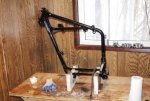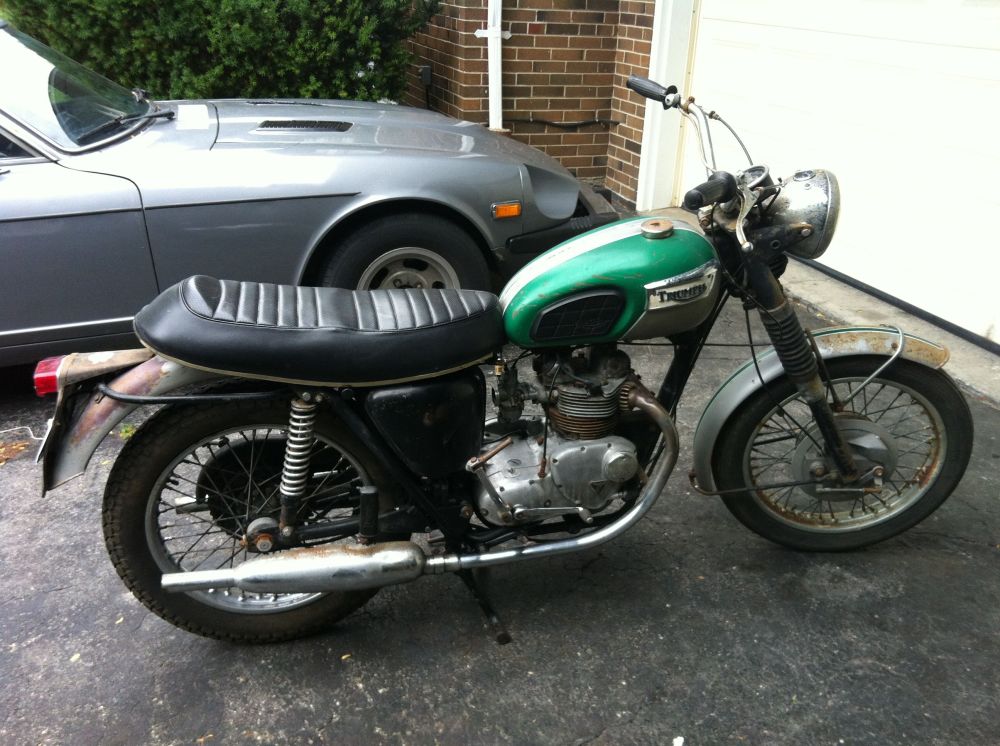My nieghbor never had a bike, and I looked at a few for him...then he finds this Triumph, parked in a barn since '84! Looked it, too, rusty, tatty, but complete. And it RAN!!! sounded pretty good, no knocks or clanks, and it didnt smoke. So we rolled it in the truck, and I took it all apart.
He found another one, w/o an engine, and we grabbed the front end off it- TLS, the other TLS front end is for sale- and I got it all stripped down....as soon as I can get that crank pinion off, Ill split the cases and have the crank boiled out. The frame & swingarm is powdercoated, the tin is getting painted at a pro shop...got most of it in the basement, right now. Petrol tanque is gorgeous.
I got 2 wiring harnesses, which Ill strip and using the listed color codes, make a new harness incorporating a 4 fuse box, Boyer ignition, Podtronics volt reg, and run the headlamps, horn, and ignition thru relays, so that marginal Lucas switch gear dosnt have to work so hard, and the crummy kill switch and connectors dont make for voltage drop @ the Black Box....
Right now Im waiting to see what the crank looks like- boil it out, new big end shells, at least- new swing arm bushes/pivot. Roller steering head bngs...Ill try posting pics as I go. Bore are nice, the clutches needed to be pryed apart they were so stuck after 30 years. Just a re-ring, no need for boring/pistons. Ive been cleaning nuts & bolts and polishing a lifetime of tarnish off the case covers.....is there a local old Brit shop in the GTA? A squirrel sitting on a vast parts pile? Just the thing for a long winter.....its been a while since I had my mitts on one of Her Majesties finest.....
He found another one, w/o an engine, and we grabbed the front end off it- TLS, the other TLS front end is for sale- and I got it all stripped down....as soon as I can get that crank pinion off, Ill split the cases and have the crank boiled out. The frame & swingarm is powdercoated, the tin is getting painted at a pro shop...got most of it in the basement, right now. Petrol tanque is gorgeous.
I got 2 wiring harnesses, which Ill strip and using the listed color codes, make a new harness incorporating a 4 fuse box, Boyer ignition, Podtronics volt reg, and run the headlamps, horn, and ignition thru relays, so that marginal Lucas switch gear dosnt have to work so hard, and the crummy kill switch and connectors dont make for voltage drop @ the Black Box....
Right now Im waiting to see what the crank looks like- boil it out, new big end shells, at least- new swing arm bushes/pivot. Roller steering head bngs...Ill try posting pics as I go. Bore are nice, the clutches needed to be pryed apart they were so stuck after 30 years. Just a re-ring, no need for boring/pistons. Ive been cleaning nuts & bolts and polishing a lifetime of tarnish off the case covers.....is there a local old Brit shop in the GTA? A squirrel sitting on a vast parts pile? Just the thing for a long winter.....its been a while since I had my mitts on one of Her Majesties finest.....
Last edited:



